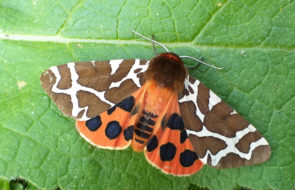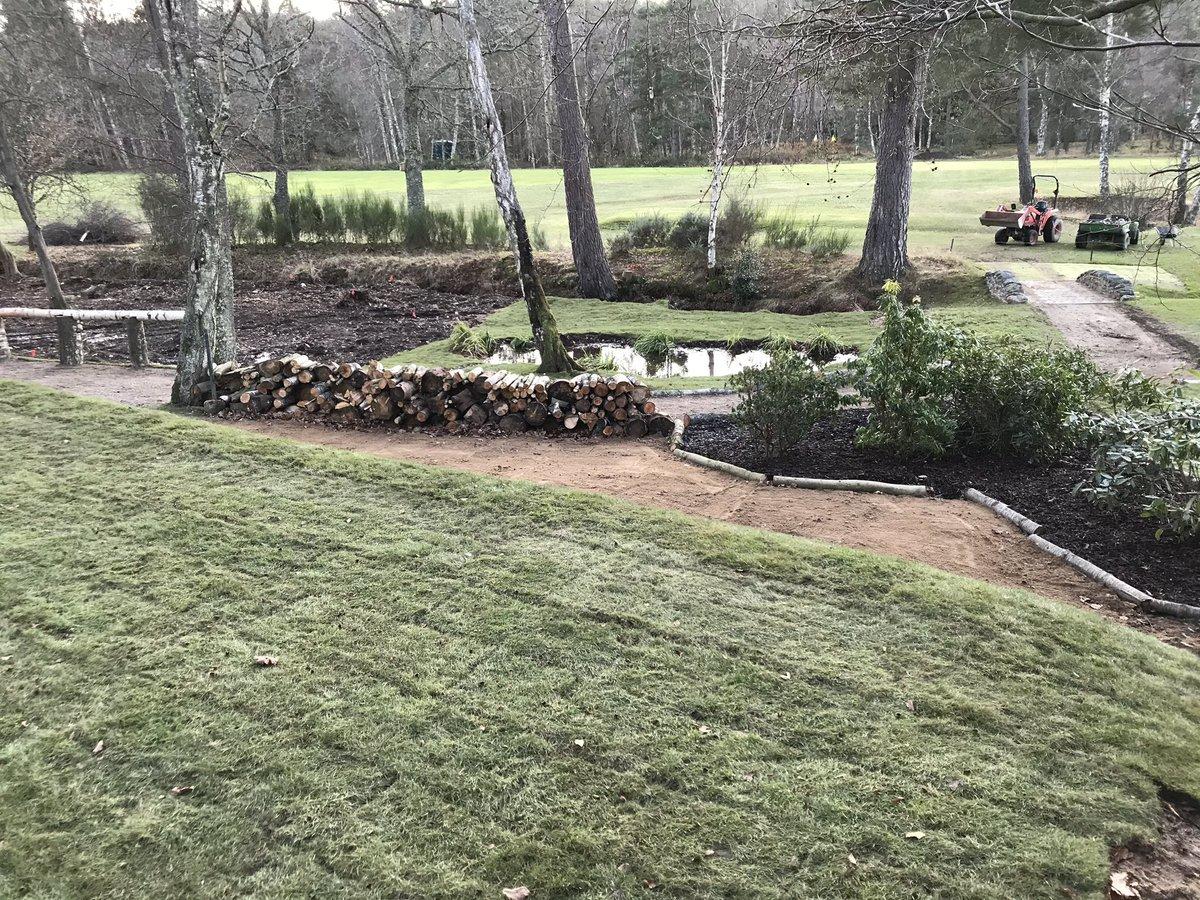- Homepage
- About
- Greenkeeping
- Ecology Bulletin
Ecology Bulletin
James Hutchinson is the Membership Services Manager ( Ecology & Sustainability) and regularly writes an Ecology Column for Greenkeeper International. If you are a BIGGA member and are interested in a visit from James, please contact him:
Golf Course Ecology Visits - 2022
Golf Course Ecology Visits - 2021
Golf Course Ecology Visits - Autumn 2020
Last blog of the year!
Well what an odd year that was. The less said the better, I think we’re all agreed on that one. It goes without saying that less golf means more wildlife – but the wildlife doesn’t pay the mortgage or rent does it.
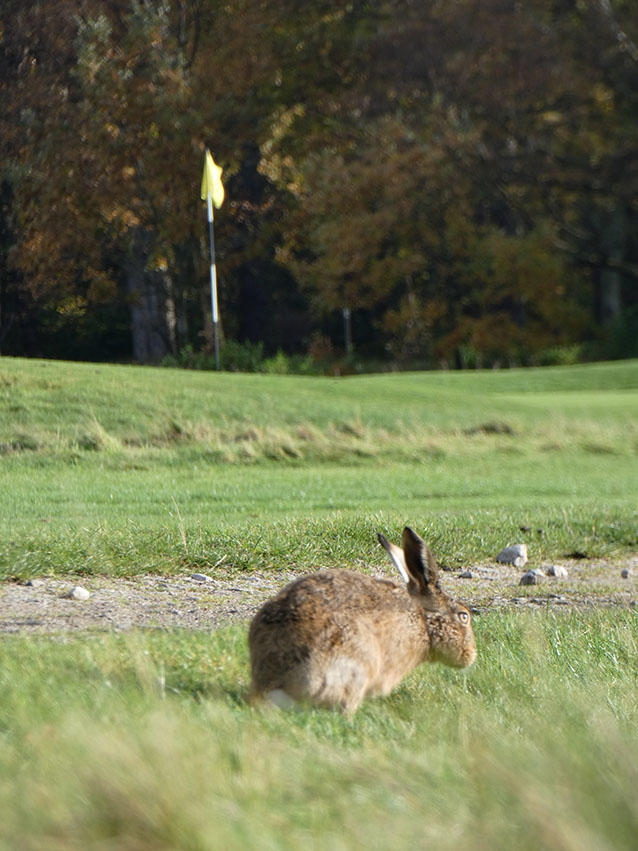
Anyway, enough doom and gloom for today, how about hares? Did you know that these critters can run faster than Usain Bolt? I didn’t either until I undertook a little research after seeing a few more than usual this year. Mr Bolt can do 27.8mph at full chat, our friend Mr Hare can top 45mph flat out – that’s rapid, however, it’s still 155mph short of the peregrine falcon at 200mph therefore hares are quite pedestrian in comparison. Beautiful, nonetheless. Numbers are declining slowly so keep growing those eco roughs for them to hunker down in please.
On a similar note, grizzly bears can do 30mph so if Usain finds himself running from a grizzly, well, he’s had it – first class consumer information for you right there.
As you are maybe aware, I’ve long been an advisory of sheep mowing the rough on a golf course, however, I completely understand that not all courses can do this for a number of reasons – no access to sheep for a start - but WINSTON golf over in Germany have it down to a tee as the snap shows. Fab stuff team!


Wait until you get a load of Cold Ashby and the bug hotel’s they are on with. There has been a dramatic rise in these posh fauna residences of late, and some are quite spectacular. I particularly like Ashby’s attention to detail and the fact that their flatpack B&B was designed in the agronomy facility - Super work CA!
Let’s hope that 2021 is a little more engaging.
James Hutchinson.
Golf Course Ecology Visits - August 2020
If you’re going to set up an owl, kestrel or any kind of raptor box, then it’s probably best if you seek professional advice, and that’s just what Hunley Hall GC did.
Course Manager, Greg Fitzmaurice and the team knew that there were owls onsite and that they hunted in the eco roughs at dusk. I had the pleasure of staying at the club’s hotel a few year’s back and remember hearing the hooting of tawny’s, so all was good there. But little did they know of the success that awaited their venture into big bird encouragement.

An experimental owl box was erected a few years back just to see what was what, and if anything would be interested in the available real estate. A long story short would be that they have had huge success with tawnies and the increasingly rare barn variety of owls which are now in residence.
Greg and the team work closely with Tees Valley Wildlife Trust and as such, took the professional advice on offer. The consequence of this advice is that they have one of the best golf course owl breeding programmes you are likely to find, and some of the best hunting ground roughs around.


I guess the objective of this blog is to highlight the often free and sound advice that greenkeepers can take. BIGGA has many resources available to our members so please do ask, however, Greg and the guys at Hunley, given their pro-active thinking and quizzical nature are now the proud ‘parents’ to a total of 8 barn and 2 tawny owl chicks since last year. Fab work, team and a success story of the highest magnitude.
James Hutchinson.
Golf Course Ecology Visits - July 2020
It’s good to be back! Even if us humans had to stop what we were doing for a while, the wildlife didn’t. It was business as usual for our feather chums, wildflowers grew whilst the butterflies took full advantage of us lot not being around.
If I were to say that well over 300 tags came in over the Twitter social media platform since furlough, then I wouldn’t be exaggerating. Obviously, there are too many to include here in the mag, so here’s a few fizzers to be going on with.
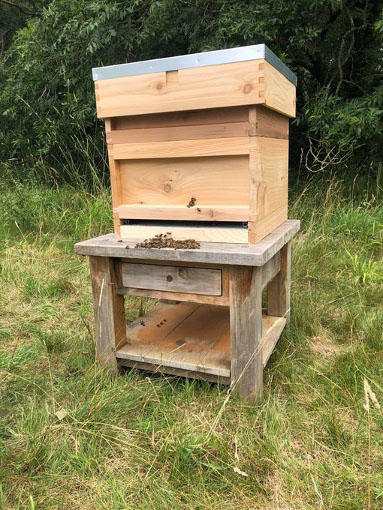
Wait until you get a load of the beauty which turned up at Purdis Heath, a white admiral butterfly. I’m jealous I’m not ashamed to say as I’ve never seen one. Great snap, team.

Chipstead don’t do things by halves…. look at the size of this fella! A friendly poplar hawk moth to be going on with.

Ardfin gave us an emperor moth of the highest order – a hypnotising beauty if ever there was one.

Whilst Clitheroe are up to their usual environmental tricks by releasing hedgepigs onto the course – fabulous stuff.

If it’s birdlife you’re after, then look no further than these course’s and their eco work. Hindhead have a whole bunch of nest boxes in use.

And there are kestrels at Morton Hall; six actually.

Whilst Ormskirk are trialling a new pesticide. Happy ecoing greenines.

James Hutchinson.
Golf Course Ecology Visits - March 2020
Course visits this past month were non-existent and the @Ecology1BIGGA twitter feed didn’t half slow down. I won’t dwell on the reasons why, but let’s concentrate on the plus points that might come out of all this.
As we’re down to essential maintenance, I’m guessing that areas of your course’s long rough may not be mowed, and, because of this, you just might see many more individual bits of wildlife milling around the site.
Take butterflies for instance, they’ve been emerging for weeks now and they need grasses and the associated wildflowers to survive. An example of this is the meadow brown, a beauty of a butterfly but one that needs medium length grass (such as unmown rough), selfheal and yarrow to survive – I’m thinking most course’s here in the UK will have all those growing these past few weeks thus will potentially see more meadow browns.
Or how about the vividly lit small tortoiseshell whose main foodstuff includes thistles, ragwort and dandelions – could there be more of these wildflowers on a golf course this year? Probably, but every cloud has a silver lining and all that kind of thing, as you’ll potentially see a larger number of small tortoiseshells – and that’s not a bad thing, is it?

Occasionally I see a real beauty on a golf course. Two that stand out are from West Lancashire and Alnwick Castle Golf Clubs; I’m certainly no expert lepidopterist, Ken Brown the now legendary golf commentator is, but I’m not. I can, however, identify most of the UK’s butterflies but I was caught napping when a small, orangey coloured sort fluttered by whilst I was working at West Lancashire Golf Club, Blundellsands on the North West coast of England.
The critter in question was a wall. Yep, you read right, wall. It’s actually called wall. (Lasiommata megera)

Numbers of this fizzer have declined so much so that it is now a Priority Species in the UK’s Biodiversity Action Plan, 2007. You are now only likely to see it on the coast, which is sad but there we go. Great work West Lancashire for developing the correct grassy habitats for this dwindling Nymphalidae.
A visit to Alnwick Castle Golf Club resulted in a real elusive chap, a White-letter Hairstreak. Alnwick is situated in Northumberland, North East England as such, is definitely not a place where you would expect to see a WLH; they are more suited to the warmer, Southern parts on England.
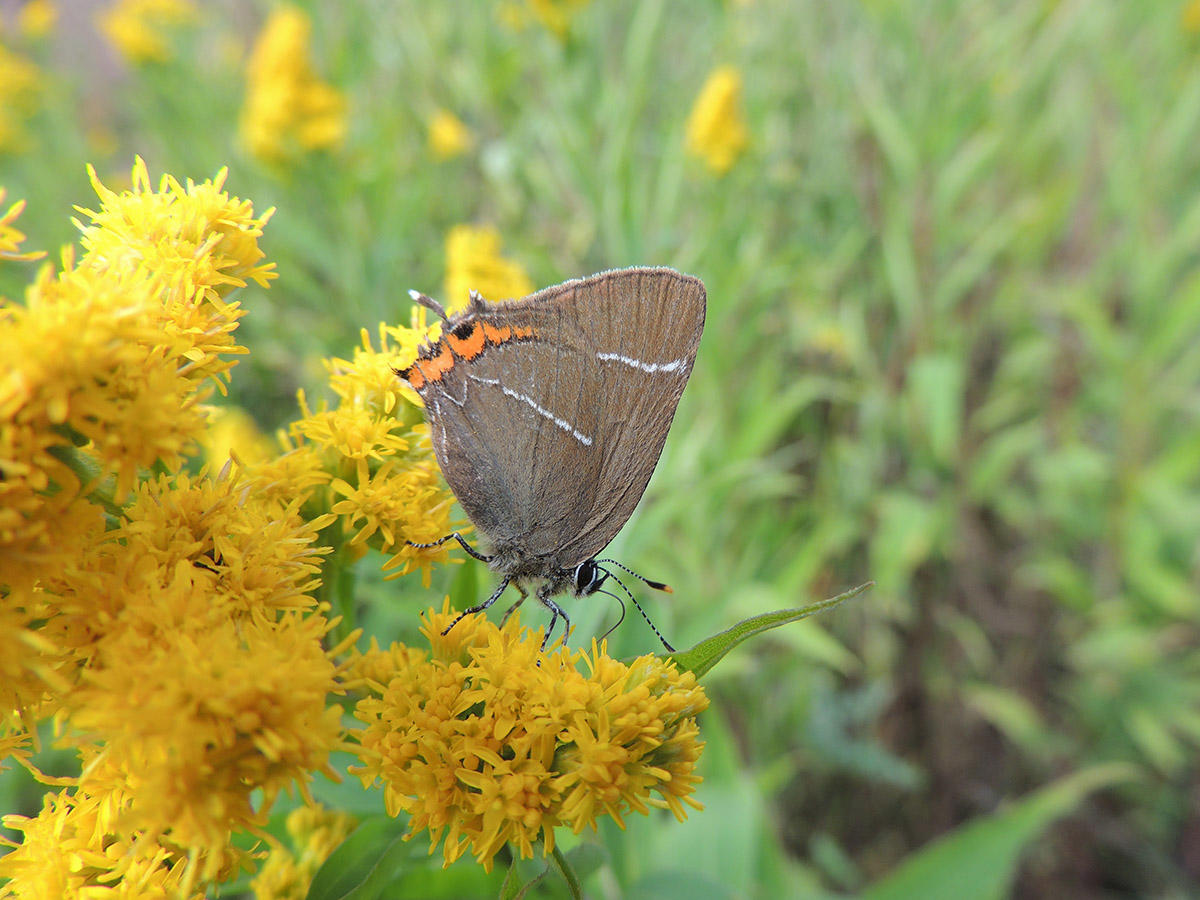
The WLH’s decline is largely, if not solely, down to the loss of elm trees in the 70’s and 80’s; elm is their favourite grub you see but we don’t have many elms left. The Dutch Elm Disease wiped many of them out – this had a knock-on effect and there’s now not many WLH’s left to see, certainly not way up North!
Whichever butterfly you see on your course, be sure to take note of its colours, flight pattern and habitat – you just might have found a real fizzer!
Golf Course Ecology Visits - February 2020
It’s been wet. You don’t need me to tell you it’s been wet, but wet it’s been. You’re probably aware by now that these blogs are aimed at light-hearted ways of managing wildlife, woodlands and so on, however, some months very little comes my way in terms of ecology, sightings, new management methods, but do you know what? February wasn’t one of them as TONS SWAMPED IN TO MY INBOX!

Would you take a look at the fab work Mendip GC are doing with their leylandii removal. It appears that these dense trees have been growing for the past 20-30 years (or more), and, as a result, are now shading out the sun to the all-important playing surfaces below.
It is known that little wildlife uses these trees in comparison to an old oak, hawthorn or ash…it is also known that they tend to fall over prior to reaching full maturity, which is not ideal on a golf course given the fact that mowing and/ or golf play is undertaken beneath them. Super work, Mendip!
Over to Rugby GC now and their woodland management.
How about this pyramidal ecopile? When tidying a wood, scrubland or any other habitat, it is important that some is left for the critters that reside there, and that’s just what the chaps did here – I’m thinking hedgehogs, stoats, wrens and many other small sorts will use this over time. Lovely.

Now then, wait until you get a load of what Hesketh GC has been up to. A small area adjacent to the carpark was noted to tangled with dead brambles, gorse and other prickly types; yes I know they’re important too…the team understand this and have mitigated by scraping away the top soil for sand bees and any cold blooded amphibian passing through. AND, wait until you hear this, invited the local primary school to help sow the native wildflower seed they purchased and erect the nest boxes. Just how good is that!?

Still on the subject of nest boxes, it’s never to late to erect a next box on your course as the following snaps show. Both Royal Jersey and Romford are doing just that and we hope to see what moves in over the next few weeks. My guess is either great or blue tits as both take readily to man-made boxes. Smashing work anyhoo.

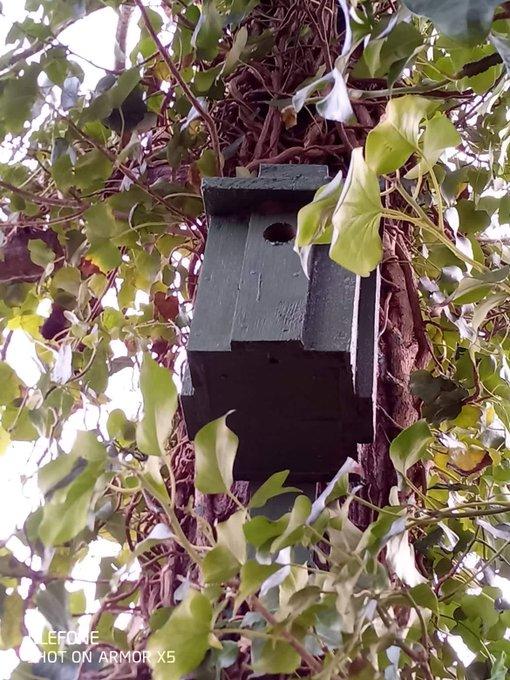

And finally, how can we top this snap from the now legendary Richard Mullen from Banchory GC. The course runs parallel to a hugely scenic river (I know, I’ve seen it) but have a gander at this snap of an otter with young. Richard took the photo whilst out working recently and his caption was “the one reason I carry my camera with me, even when cutting greens”. The outcome of this blog is thus – always carry a camera :0)
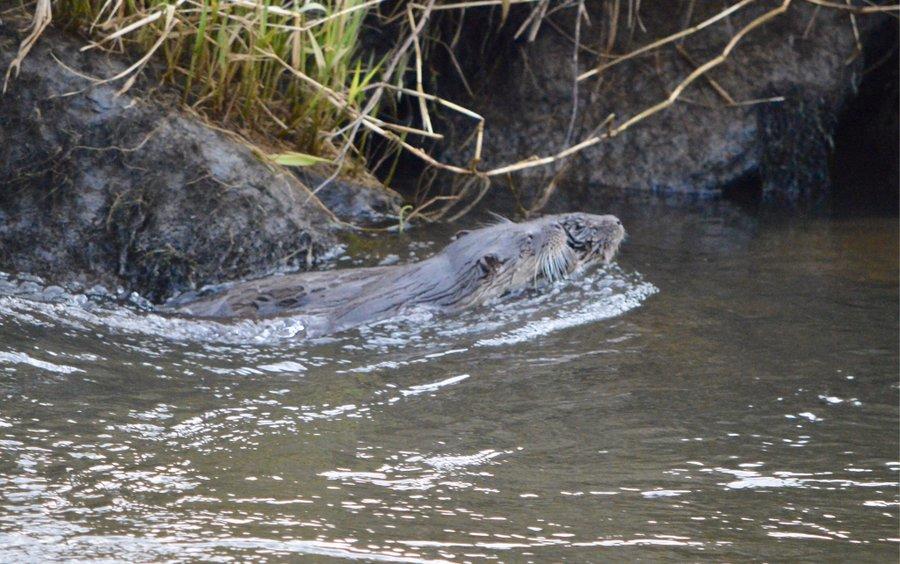
Golf Course Ecology Visits - January 2020
It might have been that you have been living in a cave with no internet, magazine and/ or social media access over the last month or so and that you will not have heard who won the STRI’s excellent environment awards – if that has indeed been the case, then here are the triumphant bunch:
- Environmental Golf Course of the Year – Warrington
- Conservation Greenkeeper of the Year – Neil Sherman
- Outstanding Project of the Year – Dundonald
- Operation Pollinator – Banchory
- Home Unions National Award – Market Harborough
A huge congrats are in order and have a smashing time in Portugal! Having spent some time with Bob Taylor over there, I can say that the winners will learn more about golf course ecology from the great man than you can shake a very large stick at – just don’t get him started telling jokes #groan.
What with Christmas, New Year and BTME to contend with, your MSM for Sustainability and Ecology has had limited time to visit our super BIGGA members, however, a few were squeezed in and they were: Clitheroe; Mendip; Cirencester; Preston; Kedleston and Ripon – very nice indeed.
In terms of the @Ecology1BIGGA Twitter account, well that went bananas with updates, projects and sighting such as these fizzers:




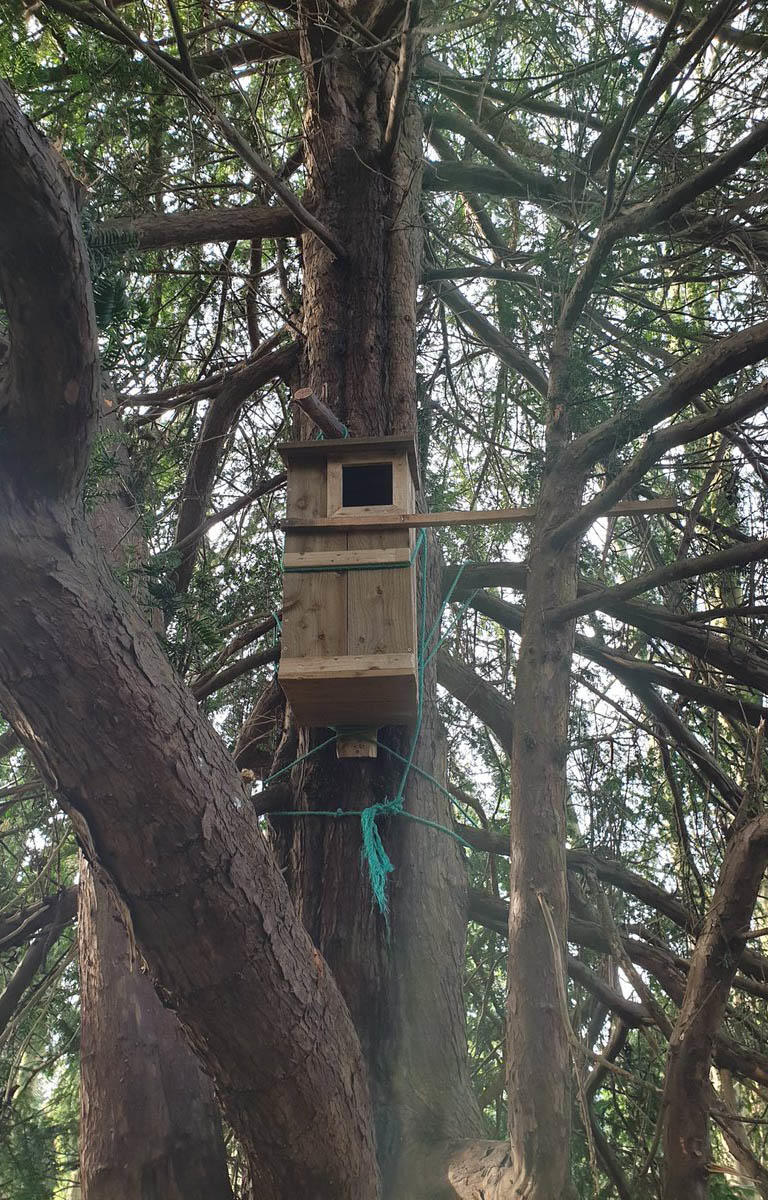
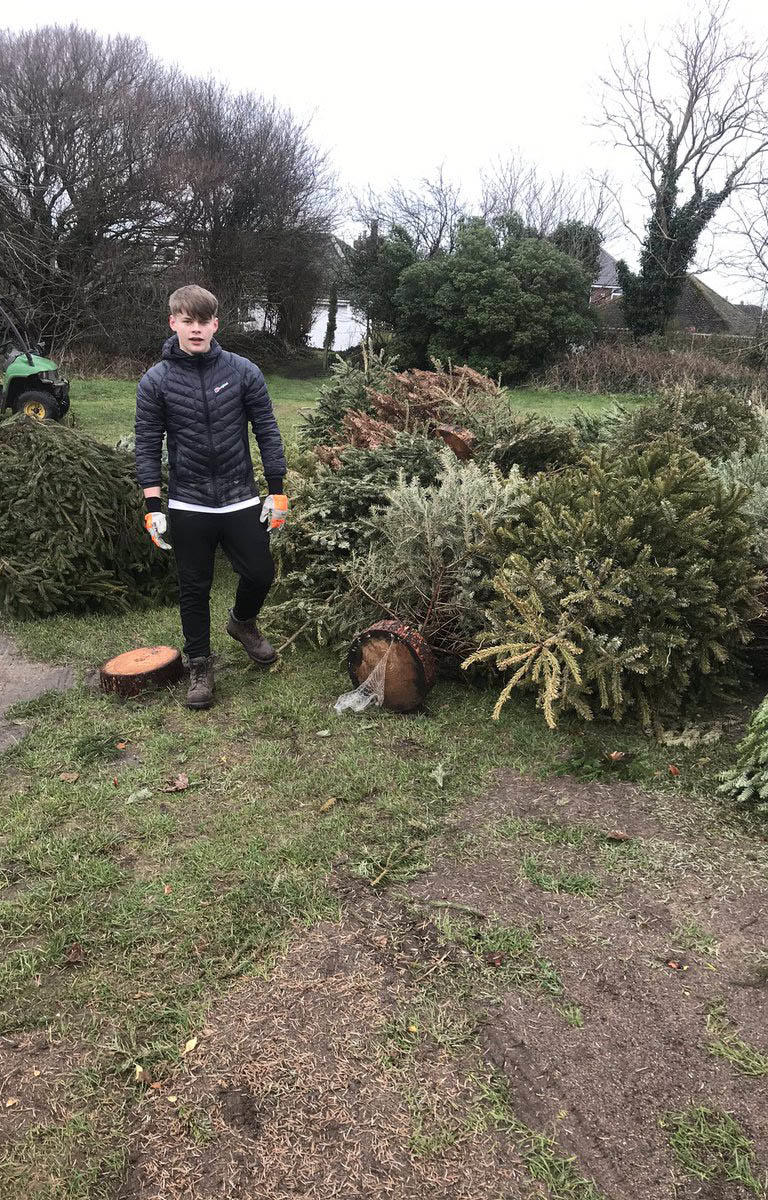
Golf Course Ecology Visits - December 2019
I guess I’d like to give you a quick update on what your MSM for Ecology and Sustainability has been up to this past month or so….so, here we go: The latest eco visits were Stirling, Ellesmere, Whitley, Hexham, Wigan, Wychwood and Normanton, all smashing courses in their own right and all having some obscenely interesting history, ecology and wildlife management on the go, indeed, some of the aforementioned have some of the oldest trees you will find anywhere in the UK!
More on those at a later date, but for now let us take a peek at BIGGA’s eco based social media account (@Ecology1BIGGA) and the juicy stuff it brings.
@GK-Erwan appears to be in a pickle with the local sheep community and the fact that they have zero course etiquette. It is highly unlikely that they will rake those hoof marks, and as for the small deposits they leave, well at least it’s compost for the forthcoming grasses and wildflowers.
Whilst @GreenkeeperPaul has a collection of nest boxes aimed at small raptors.
These look incredibly well made – best of luck Paul and let us know when they are used.
@ShaunC_1888 sent us this fab snap of their handy work. I see these more and more lately but do they work?
You bet they do;
.... however, I wouldn’t expect a family of mammals to move in – I feel that these are aimed more at small insects and wee beasties that eat decaying timber.
Smashing work nevertheless.
Wait until you get a load of the work @BGCAgronomy have been up to.
They had a small area which was unused by anything much, so they decided to create a tidier habitat for…well anything that wants to use it.
They now have a small wetland, log piles and nest boxes on the go – fab stuff all.
See you soon.
James Hutchinson.
Golf Course Ecology Visits - November 2019
It’s presentation season here in the BIGGA eco section.
Approximately 105 greenkeepers were presented to from Camarthen to Inverness, and from Surrey to Aberdeen with things like woodland ecology, recycling, ancient trees and the all-important and exciting composting - well I find it exciting, but I’m a bit…strange. Here’s Wendy Cole from the R&A and John Young from BIGGA keeping us suitable educated on their respective subjects.


Talking about compost, now you’ve collected all your leaves, why not turn them into useable material? It’s dead easy, all you need is a small digger and some space – I understand that not everybody has a small digger and some space, however, you can create humus (the desirable end of composting) in a small space and a fork, that’s just a smaller way of doing things.
To create good humus, you should have grass clippings, brown waste i.e. potato peelings/ cardboard and the main ingredient, leaves. In an ideal world, you would have four composing piles on the go at any given time with one of those piles being left to mature; do not add any further organic material to this pile as it will never become stable. The remaining three should be turned over once per month to add air; as with healthy soils, air is the key!
Once you have used your mature pile (mix it with recycled bunker sand to create an excellent conditioner) then you should leave an existing pile to mature whilst turning the remaining two over; a new space is created by using the mature pile and this is where you start a new one.
All easy stuff which any team can carry out, albeit in different sizes.
In other news, wait until you get a load of West Lancs GC and their extraordinary wildlife. The GEO certified course, situated on Blundellsands, Liverpool is a true haven for all sorts of goodies including orchids, lizards and what have you, but how about this for a bird? It’s a short-eared owl. These fizzers migrate to the UK from parts of Russia, Iceland and Scandinavia and I feel it really is an honour to have one hunting on your course.

Golf Course Ecology Visits - October 2019
Firework season is upon us, and I don’t mean the ones you light and have to retire to a safe distance. I’m on about the colourful bangers which protrude from the ground or a decaying tree stump.
That’s it, you got it, fungi, those beautiful looking capsules which all golf courses have somewhere or another.
I won’t go into detail on how they grow or how they hold a symbiotic relationship with the grasses on your tees or fairways, but I will say this, don’t eat them unless you are 100% sure that it is safe to do so. Destroying angels look awfully like your common field musher, as do death caps, the difference being is that you’ll be on borrowed time if you choose the wrong one. With that in mind, it’s probably best to simply admire them and let the slugs, deer and squirrels do the eating.
Take a look at these fruity beauties. These are in the process of depositing their spores all over the place - they are growing contently on Camarthen GC (South Wales) and Jurmala GC (Latvia). BTW, the group of people in the snap are from the BIGGA education day at Camarthen GC where I’m happy to report that a smashing time was had by all!


On occasion, I come across a critter which gives the greenkeepers a real headache; moles and badgers spring to mind here, however, Jurmala over in Latvia has beavers, mooses and a potential lynx roaming around…have you any idea of how much damage a beaver can do to your trees and golf course. I wouldn’t have believed it unless I had seen it at first hand.
These goofy furballs can down a tree and cart it off to create a dam with it. This dam then stops water leaving the course…as if we didn’t have enough problems with flooded fairways without one of these fellas adding to it.
In terms of moose, you nearly had to contact me via a séance as we (wendy Obrien, courses superintendent at Jurmala) were a whisker away from running one over on the freeway – have you ever seen the size of a full grown male moose…we have, really close up and they would make a heck of a dent in the biggest of vehicles.
Wendy took evasive action and all was good in the end.

The latest courses visited by JH were: The Hertfordshire; Harewood Downes, The Warwickshire; Gleddoch; Jurmala; Neath; Camarthen and Frilford Heath.
Happy ecoing!
Golf Course Ecology Visits - September 2019
The obscenely beautiful Isle of Man was on our hit list this past month with all nine courses visited over the three-day recce. If it’s views, history and wildlife you’re after then I really do suggest heading over to play the golf on offer, in fact, one of the courses has the incredibly rare chough bird in good numbers but you’re likely to hear it before you see it though.

The majority of courses I visit have some kind of mascot, wildlife or other form of animal to lighten the mood on a rainy day, some are called “Director of Happiness” and other such light hearted stuff;
Douglas GC are no different with their adopted moggy called Missy - aint she a beauty! She regularly brings in rabbits so pest control is high on the list for this furry feline.


The GEO (Golf Environment Organisation) are doing some fine work of late with their OnCourse and full Certification programme – have you given a thought to joining up? If not then here’s a link for further info: https://sustainable.golf/get_involved
Their yearly steering group meeting was held in North Berwick recently with many super ideas for the future of greener golf being bandied about. Super work GEO! Here’s a snap of the group representatives from Switzerland; Italy; Scotland; Sweden; England and Portugal.
All the Isle of Man courses; Blackpool Park; St Andrews Eden Course; Rothes; Banchory; Stonebridge; Gathurst; The Hertfordshire; Harewood Downs and The Warwickshire were all recipients of a visit from myself with Gathurst taking up a full 18-hole environmental report.
And finally, It wouldn’t be a blog from your MSM for Sustainability and Ecology without a picture of a tree, would it? So, here’s one. A ripper of a sweet chestnut at The Hertfordshire GC.
Measuring almost ten metres in girth. Who knows how old she is, but there was a monastery next to it almost 1 thousand years ago and we know that monks used to plant these trees for the fruits they gave off. A nice thought to have a millennium old tree growing on your course isn’t it?

James Hutchinson.
Golf Course Ecology Visits - August 2019
It’s happened! I knew it would sooner or later. Something had to show up given the amount of time I spend mooching in the woodlands and the roughs of golf courses. This particular happening happened at Burford GC on 22/08/2019 at about 11:30am where a grand total of 16 of them were found.
First-Nature, a hugely respected online magazine mentioned ‘don’t expect to find a carpet’…but that’s just what we did, a carpet of stunning rarities which are now in the process of being recorded by the Botanical Society of Britain and Ireland as we speak. I suppose you are wondering what I am on about? Rare orchids, White Helleborines to be precise.

These beauts only grow in certain habitats and it appears that Burford GC has them spot on. As a rule, they only grow in chalk or limestone mediums and under veteran beech trees where disturbance is minimum.
Here’s an interesting snippet about white helleborines, they can take up to eight years to grow from seed (which is microscopic) and an additional two years to flower – how interesting is that!? Unfortunately, we were to late in the year to see them in flower but fear not,
I shall return next June/ July to photograph these obscenely pretty wildflowers. Here’s the best snap we got.
A recent jaunt to Coventry GC unearthed a smashingly large oak tree thought to be about 450 years old, give or take a few years. What made it more interesting is the practice of filling in cracks with concrete.
This particular oak had cement poured into a large fissure at some point in the past and it appears to have worked a treat!

I am certainly not suggesting that you pour cement into your trees at all, but that is just what past arboriculture chaps used to do to fill a decaying cavity, just like a dentist does.
However, modern research suggests that it can potentially damage the tree further because trees are always moving whereas the cement does not – this just causes more fissures and cracks as the tree moves in the wind.
Anyway, Coventry GC has one on show, and aint it a corker!
The club’s who took up visits this past month were Grange Over Sands, Worsley, Blackley, Chorley, Myerscough, Romford, Burford, Wilmslow, Coventry and Kedleston Park.
If you’re a BIGGA member and require advice on environmental management then let me know and I may be able to help.
James Hutchinson.
Golf Course Ecology Visits - July 2019
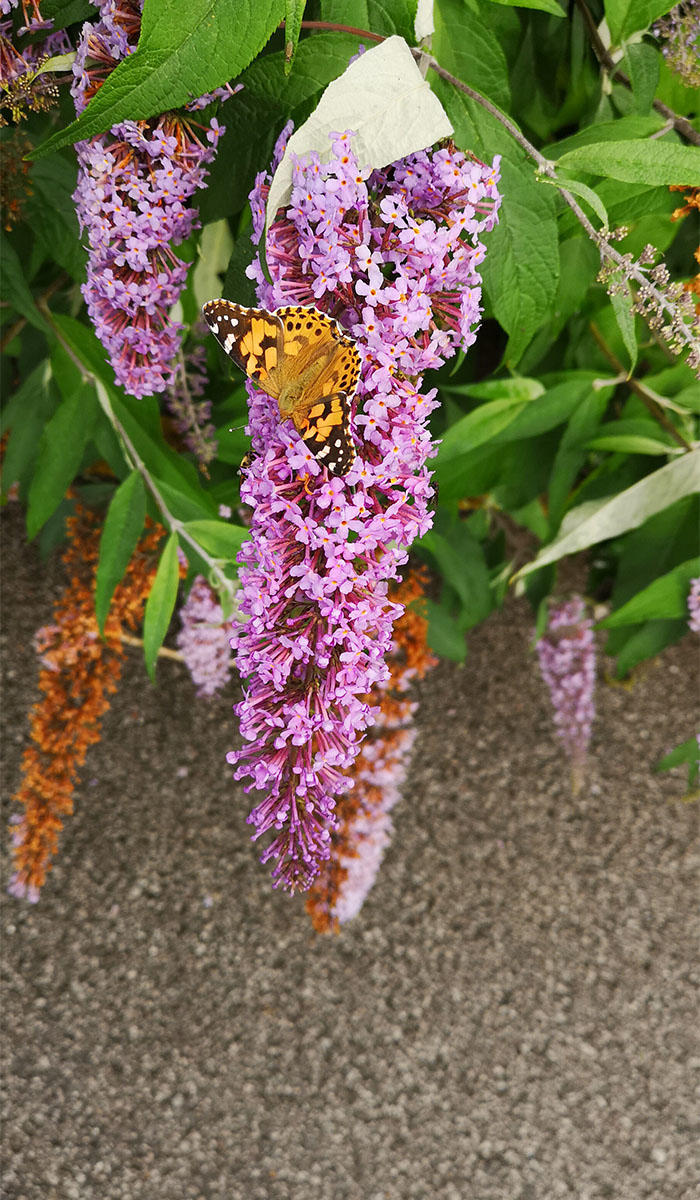
July Visits and Painted Lady Special
July saw what can best be described as an influx of painted lady butterflies from North Africa with the majority of golf courses visited suggesting they have them in good numbers.
This en masse arrival apparently happens once every ten years and guess when the last mob arrived? Yep, that’s right, 2009. If you have a buddleia (also known as the butterfly bush) onsite, and you probably do as these things are hugely invasive, can grow on the side of abandoned buildings and pretty much anywhere that has soil, then take a peek and see how many butterflies it has on it – tons I bet! I’m certainly not suggesting you plant buddleias on your golf course however, if managed, this shrub can be a great asset to the pollinating insects you have.
In terms of visits, it’s been busy with La Moye, Royal Jersey, Crewe, Whitley Bay, Boldon, Baberton, Morton Hall, Gathurst, Newbury and Crookham, Mendip, Cardigan Bay, Portmore Park and Moor Allerton taking up an eco-visit, with Mendip having the full treatment of an 18-hole ecology report. As always. Let me know if you’d like a visit or report and I’ll do my best to help out.
Now then, the mercury rose for @GK-Erwan when he found this poor deer on his course that had been tangled up in a sheep fence for who knows how long (photo via Twitter). Our hero gently cut away the fence and off went the deer, no doubt without thanks – fab work sir!


Another course sighting was this snorter from @gmway. I’d prefer to shooo the deer away than this big girl.
Happy Eco-ing!
James Hutchinson
Orchid Special for June 2019
With orchid season in full swing, it’s hardly surprising that our inbox is jam packed with photos of these colourful beauties from your golf courses, but did you know that some are really common?
On the other hand, some are extraordinarily rare so let’s take a look at a few of these leaders of imitation shall we.
Starting with the most frequent type, the common – spotted orchid can be found anywhere where the ground is damp for a portion of the year (which is most golf venues).
This attractive wildflower has an aromatic perfume which attracts many day flying moths and pollinating insects making it an important part of our biodiversity – hooray for the common, common – spotted orchid I say. Here’s one from Crewe GC.


I mentioned leaders of imitation earlier on, and the bee orchid is a fine example why….it looks just like a bee!
This fabulous flower has evolved to mimic a female bee so that the blokes, when the flower has omitted its female bee scent, try to mate with it and as a result spread pollen out to other bee orchids – how smashing is that! However, the UK’s bee orchids are self – pollinated so I guess there’s no need for it to look like a bee anymore.
A beauty nonetheless. This one’s from Whitley Bay GC.
On very rare occasions, a real fizzer shows up. The lizard orchid can be found at a handful of sites and it just so happens that Royal Jersey GC has one. And here it is – aint it a belter! This type of orchid smells of goats apparently.
Once in a lifetime, an orchid shows up which takes everyone off guard and sends the botany world upside down.
There is one that haunts our woodlands when it can be bothered to - the ghost orchid is about a rare a wildflower as you can get with the Ghost Orchid Project team suggesting:
“In 2009, after an absence of 22 years, the Ghost Orchid was rediscovered in British woodlands, sending the Botanical world in to a spin. Last officially recorded in 1987, there have been many unconfirmed sightings dating up until 1999, and with periods of up to 37 years between flowering, there is every chance that one will turn up again.”
Do you know what? It wouldn’t surprise me at all if one showed up on a golf course this year, which brings me around nicely to an orchid which is so rare it has police protection.
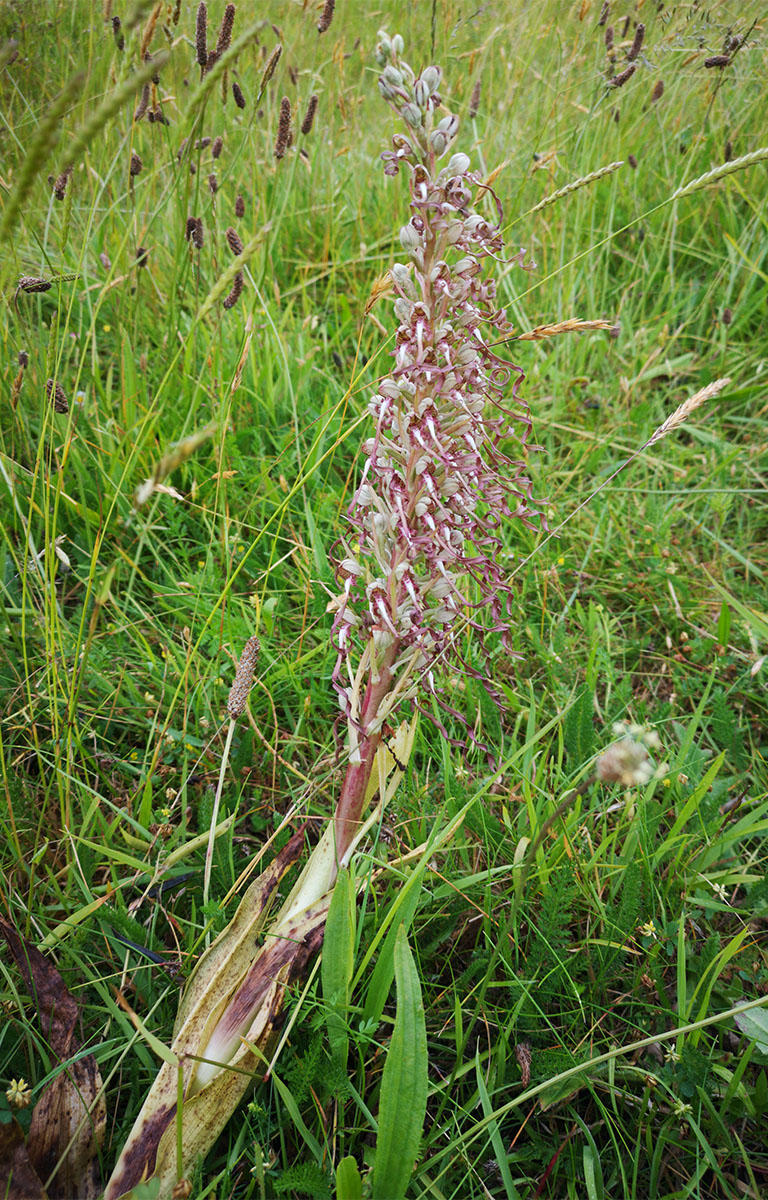
The lady’s slipper orchid was once thought to be extinct here in the UK until one showed up a few years back launching orchid hunters into hyperspace. Take a guess where it was growing? That’s right, on a golf course. Silverdale GC had the pleasure of hosting this solitary spectacular plant; I understand the boffins at the Royal Botanical Gardens at Kew took cuttings etc. and developed a collection of new plants which are thriving at many locations in the North of England – fab work all.
Let me know if you have any orchids growing on your course.
James Hutchinson.
Golf Course Ecology Visits - May 2019
You guys never cease to amaze me when it comes to passion, enthusiasm and sheer will to do what’s best for the critters which mooch around your golf courses when the golfers aren’t there.
How are these for examples: Sean Walker at Montrose got himself through a beekeeping course and now has a healthy population of the buzzers onsite – super stuff, Sean. Or the super proactive Richard Mullen at Banchory and his work with introducing wildflowers to the course…not just that though, Richard works with the local school introducing them to the benefits of having wildflowers growing on your course – Operation Pollinator at its best I say.


But what about the naturally occurring stuff? You know, the flowers that just appear when you weren’t expecting them to. The ones that you find when you have to keep out of the way of a golf shot where even the chap who’s hitting it has no idea where it’s going to go – these tend to be the tiny vars that crop up on @Ecology1BIGGA’s Twitter feed occasionally.
This happened recently when I was developing Chestfield’s ecology plan and I stood behind a tree waiting for golfers to play through. I noticed a collection of ant hills with small yellow flowers nearby, turns out the flowers were cow-wheats…wooohooo! After a little research, these fab wildflower’s seeds are eaten by ants and taken into the ant hills for the young ants to eat. Not all are eaten and some germinate into the what we see here. Everything has a symbiotic relationship with something or other but how good is nature? I wouldn’t have found them had I not had to take evasive action.
We really do get hundreds of snaps each month but some stand out a little more than others. Here’s an example: Lees Hall had a visit by a few bees…well quite a few bees actually. Last I heard they had cleared off into the woodlands so all’s good there.

Greenkeeper James Matthewman at Maesteg couldn’t resist helping a buddy out when he offered sugar water to this little fella. Ace work, James!


Or a real rarity! A green hairstreak at Purdis Heath GC. This one’s a beaut.
Many of you took up the member benefit of a visit from myself this past month with the likes of Clitheroe (eco talk), Myerscough (eco course walk), Woburn, Brampton, Silloth, High Legh, Kedleston (full eco plan), Chestfield (full eco plan) and Aldeburgh (eco talk) taking up one of the advantages of being a BIGGA member – looking forward to hearing from you but it’s unlikely I can make it to see you before July.
James Hutchinson.

Golf Course Ecology Visits - April 2019

Another Island was on our radar and that was Arran. An obscene amount of wildlife was found to go alongside the stunning golf courses. Lamlash, Machrie Bay and Shiskine have diverse birdlife including pipits, redpoll and ringed plover but it’s their rugged remoteness that makes island golf so captivating. Here’s an example:


Other courses visited were Rugby and Worsley with the latter taking up an offer of a full 18-hole ecology report – let me know if this is something you are interested in for your course and I’ll head over for a chat.
Below is a selection of the fab snaps you guys have sent in recently.

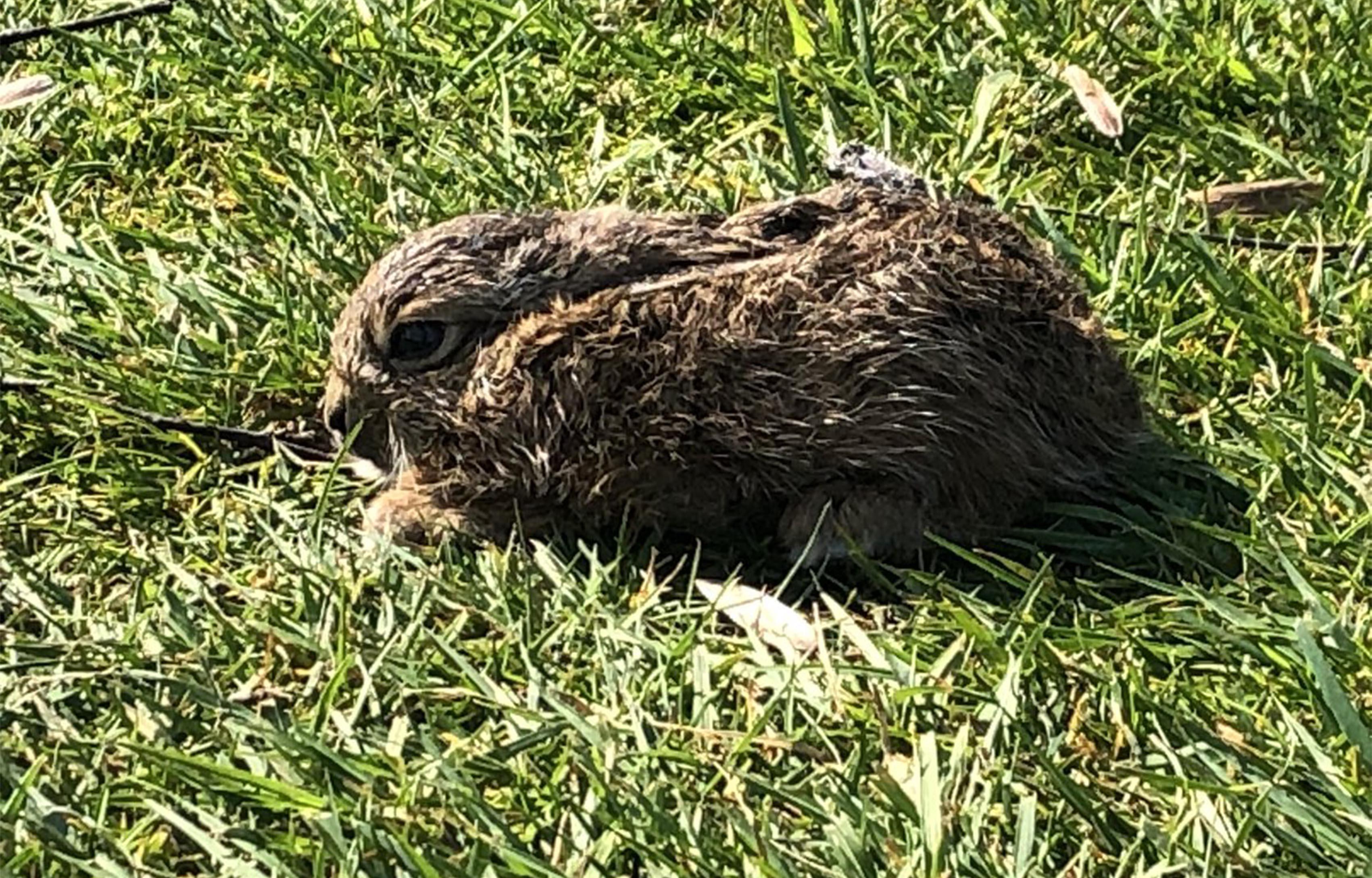







Banchory are up to their usual ace work by developing a new wildflower area.
Until next time,
James Hutchinson
Golf Course Ecology Visits - March 2019
Great news to start with, Alwoodley have just been awarded the GEO (Golf Environment Organisation) certificate for their continuing sustainable work within the clubhouse and golf course. Well done all and it was a pleasure to work alongside you! If anyone else wishes to become certified then let me know as I may be able to help.
February’s heatwave was never going to last was it with most of you reporting a ‘false spring’ with many butterflies and some reptile sightings…. well where are they now!? It’s hovering just above freezing and it hasn’t stopped raining for a week. The butterflies have gone back into hibernation not to return until the real spring springs, and as for the reptiles, well the sensible cash is on them tucked up back in their hibernacula for another month. Ah well, it was fun while it lasted.
Harrogate, Auchterader, Stirling, Muckhart, Alwoodley, Gathurst, Trentham Park, Bowood, Kedleston, Salisbury and South Wilts GC’s took up visits from your MSM for Sustainability and Ecology (James Hutchinson) recently with Crewe taking up the membership benefit of a full environmental report from us. These reports take in the golf course habitats and any other surrounding environs which require comment on and usually reach the 8 – 9000-word mark. Contact James if you need further assistance or advice on these.
In terms of snaps sent in, wait until you get a load of these splendours. Ipswich GC are seeing three different types of butterfly on the wing (red admiral, comma and brimstone) and a slow worm.
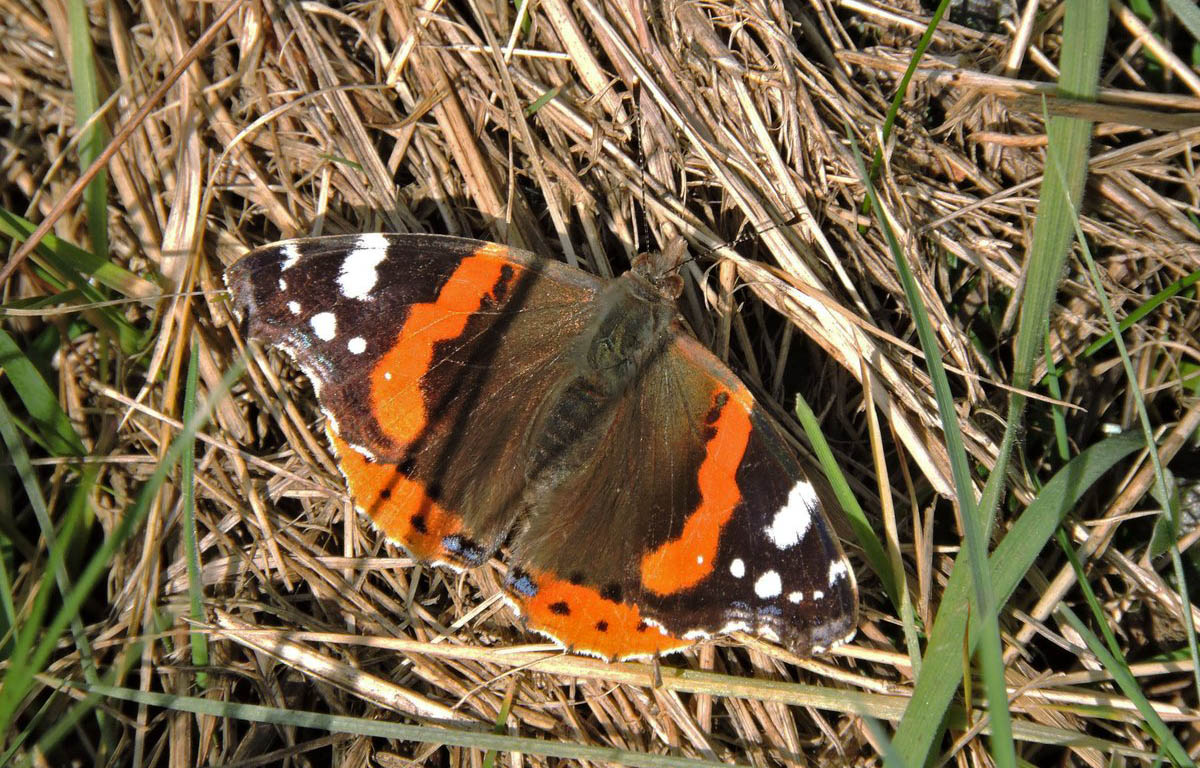



Elsewhere, there's been many nest box and habitat creation schemes being built. Take a look at these beauts.

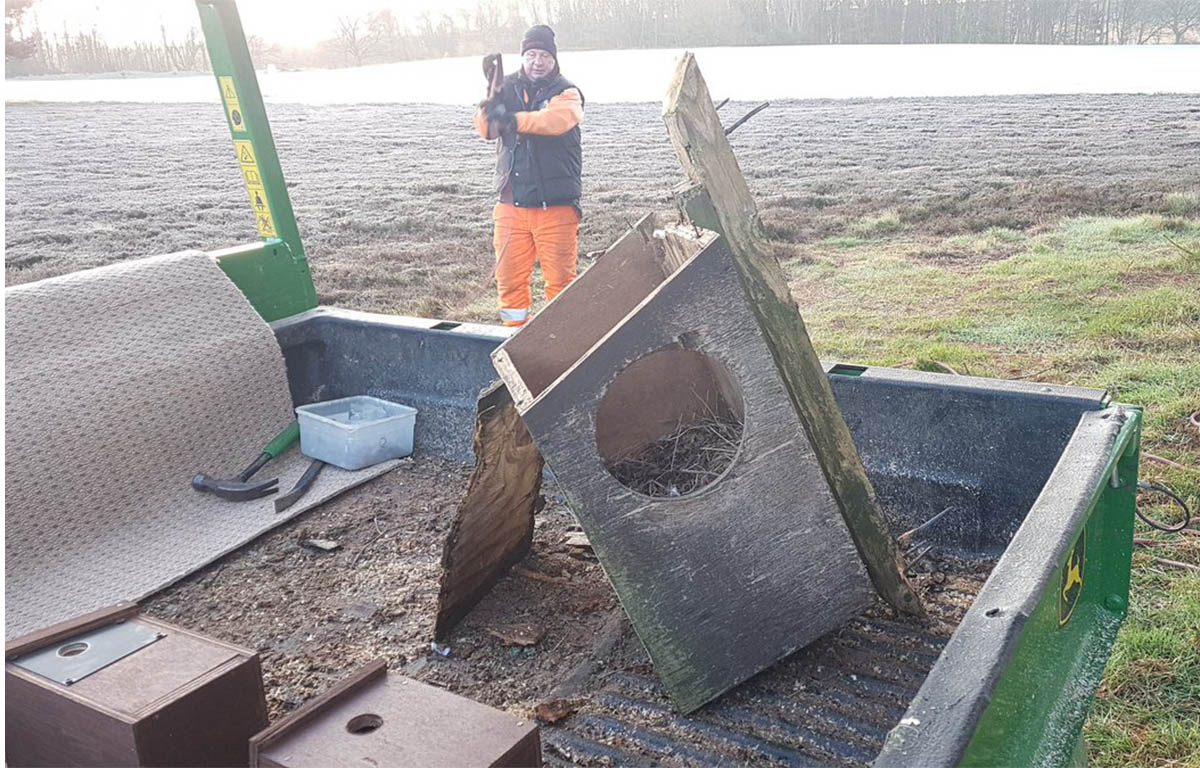
Portmore Golf Club have a stag beetle hotel up and running.

And to end with, Royal Mid Surrey are going that bit extra and donning waders to secure their floating duck box.

James Hutchinson
Ecology at BTME - February 2019
BTME took up a good deal of your Member Service Manager for Ecology and Sustainability’s time during January with a highlight being the Ecology Forum which was held in the Crown Plaza, Harrogate. A total of 40 inquisitive greenkeepers showed up and listened to presentations from Trevor Harris (Castle Course, St Andrews), Andy Riley (Warrington GC), Stephen Thompson (John O Gaunt GC), Ian Jelley (Warwickshire Wildlife Trust) and Bob Taylor (STRI).
Trevor gave us an insight into the great work the team are undertaking at the Castle Course along with information on their hugely successful kestrel box, whereas Andy offered advice on woodland management on a SSSI site.
Stephen Thompson had a smashing collection of footage involving otters and Ian let us in on the work Warks Wildlife Trust are doing with golf courses in their area, namely Coventry GC.
Bob Taylor was last on (who can follow Bob?) and spoke about widening the brief around a golf site and into the surrounding habitat suggesting that courses can, and do, stretch out past their gates and into the wider countryside.
Many thanks all and we will see you again next year.

Also, at BTME, the STRI’s (lots of acronyms there but you know what they are) held their environment award ceremony on the Wednesday evening and the tension building up to the revealing of the winners was almost unbearable. Bob Taylor and Rowan Rumball hosted events seamlessly and the winners were:
- Environmental Golf Course of the Year – Aldeburgh
- Conservation GK of the Year – Phil Stain
- Outstanding Project of the Year – Wylihof
- Operation Pollinator - Corhampton
- Lifetime Achievement Award – Gordon Moir
Good luck if you enter this year – what do you have to lose? The way I see it, you have tons to gain and don’t be thinking you haven’t done enough… I hear that statement at most courses I visit and they are usually doing plenty to warrant a visit from the STRI’s ecologists.
A simple heather regeneration programme may do. Have you built a new pond which is showing new and diverse wildlife? Or have you created innovative habitats for pipits, stag beetles or something of a larger stature? I know you have so forms at the ready – the team at the STRI will let you know when entry is open and we’ll publish it in the GI mag and via social media – good luck.
What’s been happening around the UK of late?
Well here’s a snippet of the snaps of the eco work you guys have been up to last month.






Until next time,
James Hutchinson
Birds - February 2019
Wait until you get a load of the fab sightings and eco goings on of BIGGA members of late – absolute rippers they are and it appears that 2019 picks up where 2018 left off…lots of wildlife projects from the UK’s greenkeepers!
Firstly however, your MSM for Ecology and Sustainability (James Hutchinson) has been on the road looking at ways of managing your places of work for the benefit of nature. Clitheroe; Altrincham; Garstang; Harrogate; Alwoodley; Hunley; Crewe and Moortown had visits with both Clitheroe and Crewe taking up our services in the forms of full course eco report/ plan for their respective golf courses – looking forward to working with you guys! BTW, if you ever find yourself at the stunning Clitheroe GC then spend some time looking in the tall hedgerow in the carpark…choc full of birdies it is including long-tailed, blue and great tits, thrushes, chaffinches and blackbirds.

Still on the subject of our feather friends, one of the most secretive birds in Scotland made an appearance for Les Rae of Montrose GC a few weeks ago. A water rail showed up on the pond adjacent to the courses and hung around long enough for its photo taken. These birds are hugely shy and stay hidden in the reeds for the most part. Great snap, Les!

In other feathered related news, Jim Fancey, Southwick Park GC’s Course Manager sent us a pic of an injured bird which one of his members collected from the course after it came in second place after a punch up with some crows. The falcon is now in the hands of the RSPB so keep us informed when you see it again, Jim.

If you feel inclined to help our birds out then you can take a leaf out of these chaps book and erect nest boxes in the woodlands or the maintenance facility building. Vale Royal and Rothes GC’s sent us these belters whilst Scott Corrigan has a mahoosive collection of starling boxes ready to go up. Here’s an interrsting fact about starlings, they eat chafers and leatherjackets whilst aerating the upper soil horizon – how about that! Natures very own pesticide right there. The hard part is attracting them to your course – a good place to start is communal nest boxes, just like Scott’s!
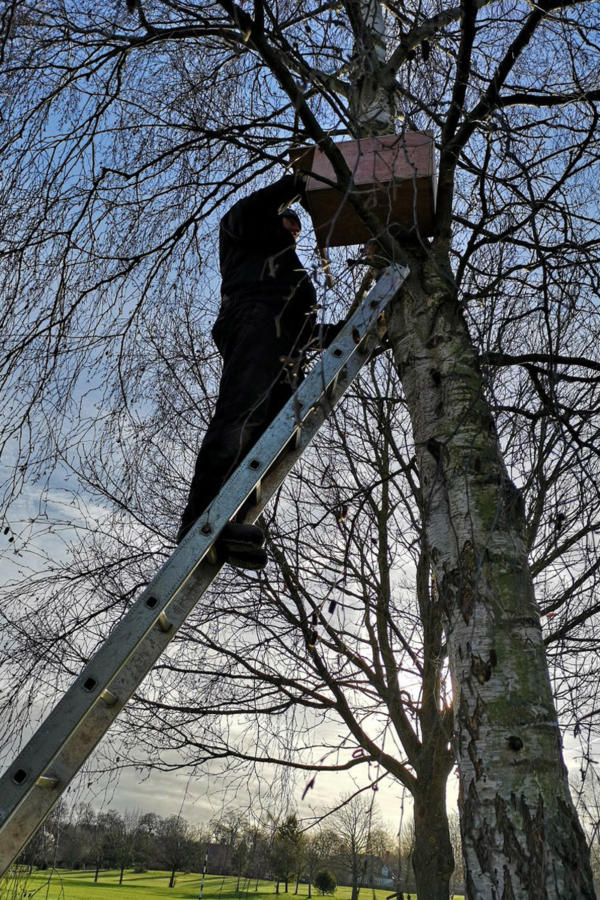
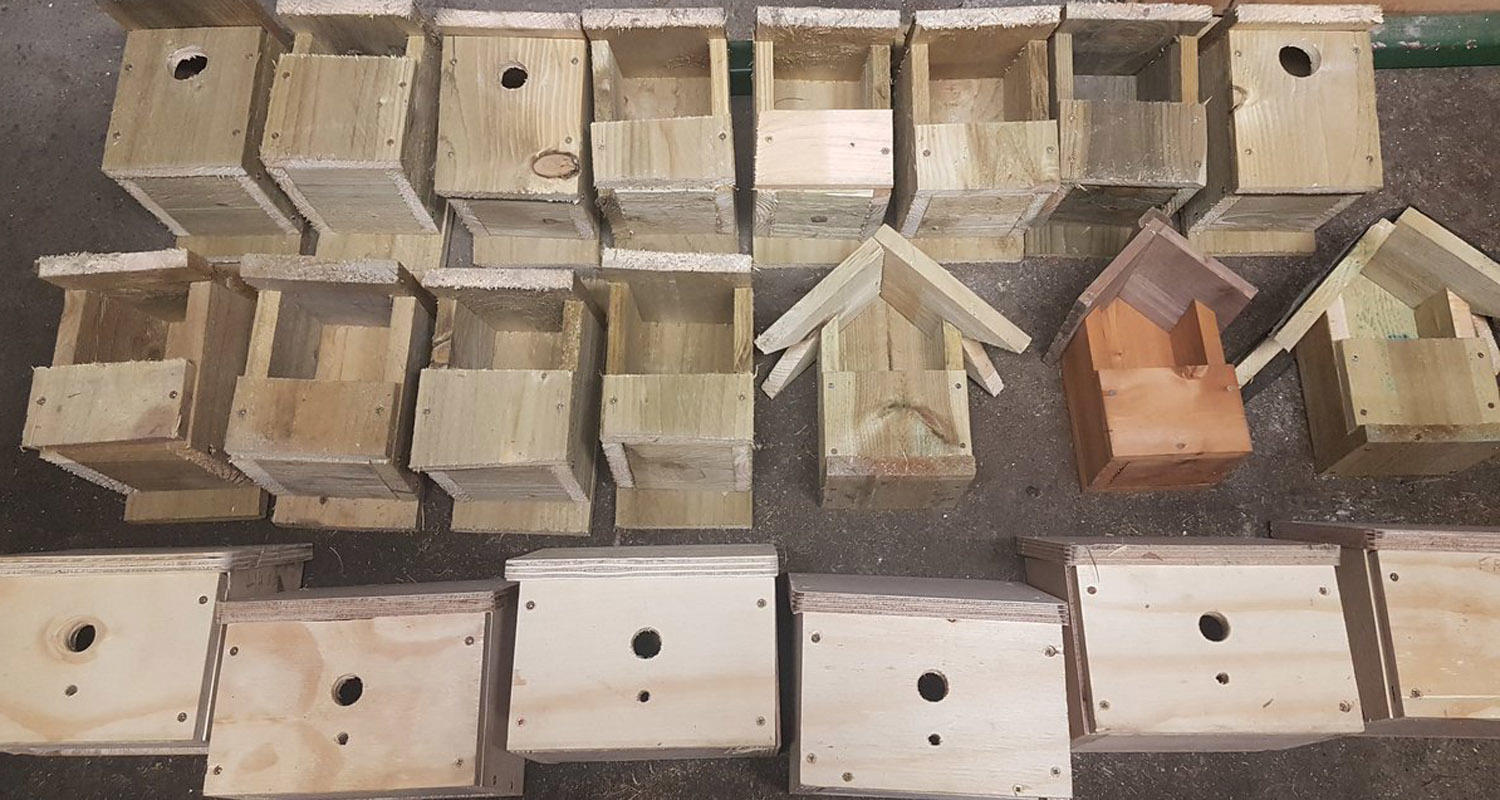

Not content on helping out the birds, the guys at Rothes GC have made this this beauty of a hedgepig habitat box. Wonderful stuff and please keep us informed if Mrs Tiggywinkle moves in guys - these prickly gaffers need all the help they can get.

Keep them coming.
James Hutchinson, Membership Services Manager – Ecology and Sustainability.
Wildflowers - January 2019

After the long and really dry summer we have had here in the UK, it is nearly time to manage your wildflowers so you can have a bumper crop next year. But how are you going do it? Here are a few tips to be going on with:
Firstly, you have to check whether you have any nesting birds or other such critters nestling down in the flowers. As we are aiming for a mid-autumn cut just after the flowers have finished, it is unlikely you will have any, but it’s always best to check isn’t it.
After you are happy there are no nesters, beat the wildflowers to remove the majority of the seeds. Depending on the size of the area, this can be done manually with a simple stick – what we are after at this point is to be sure we are giving the area the best chance of recovery next season by placing more seeds on the ground.
Next task is to cut the area with a suitable cut and collect machine. It is imperative that as much organic matter is removed at this point; we do not want decomposing material lying on the surface as next seasons shoots will not be able to break through. If possible, the cut material should be allowed to dry undercover as there will still be a good number of seeds here – this can be used next season on new areas. If your course does not have a suitable machine then manual strimming down to ground level will suffice, but be sure to rake off any overlying material and dispose of it correctly.

When the area is cut and removed, then a light verticut should be undertaken. This will give the underlying seeds the best chance of survival next year, as many wildflowers are gentle and will not tolerate too much competition from grasses. If a verticut machine is not available then a hand rake with a spring bok or other such hand tool will be acceptable. At this point, we are not interested in deep scarification and the removal of matter. All that is required is to give the wildflower seeds a base of soil-to-seed contact. It is also important that the seeds are not buried but preferably lie on the surface where they will take root next spring.
I hear at so many golf courses that “we did try to grow wildflowers a few years ago. The first year was great; the second was poor and the third we had only grasses”. I feel that most new wildflower meadows on golf courses are left to nature when built. They always fail! What you should be aiming for is to try and mimic animal grazing i.e. the cut and remove method. Give it a go – what do you have to lose when the ground is hard with frost and you cannot get onto the course to do maintenance? Head over to the wildflower meadow and cut it down.
There are of course more factors to consider such as choice of flower, pH, drainage, available light and so on. However, and as always, I am here to help BIGGA members become more wildlife friendly and sustainable. Let me know if I can assist.
James Hutchinson.
![Wildflowers for Karen[1].JPG](https://www.bigga.org.uk/static/derivatives/300x480_highestperformance_/81b5d482-32bf-4e29-b15e5f31b7102ccc.jpg)
Woodland Management - December 2018
Trees, woodlands and other related areas have long been an emotive subject and one which often causes the Course Manager/Head Greenkeeper the most issues during the winter time – this does not need to be the case as BIGGA can help with the majority of issues relating to this often troublesome problem.
Historically, trees were planted as a barrier from one fairway to another or for privacy reasons and the like - this is more than acceptable at the time of planting, however, land managers, particularly members of the committee and other golf club decision makers, forget that trees grow and as such require management, usually years and years later. The trees planted in the 60s, 70s and above are now overgrown and casting shade to the turf in the surrounding area/s beneath, not to mention that, if they have not been managed in the past and were planted too close together, have grown leggy and are all reaching for sunlight – it is these trees which often fail and fall over, at the same time prior to reaching maturity, and are now a Health and Safety concern.
There’s also the matter of trees being planted as a memorial to a past member or historical event – these are far more difficult to cut down for the obvious reasons and it may be that a green or tee has to be altered to accommodate their spreading growth or replanting with similar species is undertaken.
Other factors are ancient and/or veteran trees which are far too important to the local and visitor wildlife to cut down – I have often commented in my woodland management plans that trees such as this cannot be removed, thus the underlying tee, bunker or drainage system must be relocated elsewhere nearby.
Heathland courses are now in the minority as trees were planted onsite generations ago. Heathlands are equally as important for invertebrates and of course, golf play.
The point I am making here is that BIGGA can help with tricky woodland scenarios where a decision cannot be reached within the club. There is always a middle ground where we can meet.
Golf Course Ecology Visits - November 2018
A hugely busy month of eco presentations were undertaken by your MSM for Ecology and Sustainability with approximately 120 eager-to-learn greenkeepers presented to. Scotland was first up with talks at Kilmarnock (Barassie); Bothwell Castle GC and then Liberton GC and then down to Middlesbrough GC the following week. These talks cover topics such as grassland and wildflower management, woodland ecology, wildlife encouragement, and my personal favourite, fungus and the decomposition of timber so let me know if you would like one at your golf course (for members and/ or greenkeepers).

Along with the talks, many course visits were carried out to places like Ashton in Makerfield; Caldy; Formby Ladies; Formby Men’s; Worsley and Shaw Hill with more already booked in for December - these visits always throw-up interesting sightings including grey wagtails and dippers although the grim weather has made clear photography difficult of late so we’re a bit thin on the ground in that department I’m sorry to say…maybe next month I’ll have beautiful snaps of rare and exotic birdies for your enjoyment. There were however, lots of mushrooms milling around and take a look at these terrific fescues growing at the fabulously managed Caldy GC! This is Carl the HGK modelling his and the team’s hard work. Super stuff.
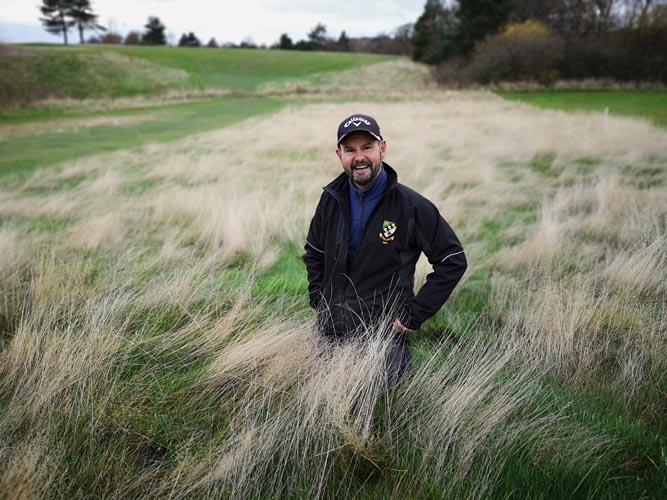
The @Ecology1BIGGA Twitter feed has gone berserk too with goodies sent in from all four corners of the UK. Take a look at some of the great work greenkeepers have been doing recently: Ipswich GC have been managing areas for the highly elusive harvest mouse and their work has resulted in three old nests found whilst cutting the reed back.

Perennial ecologist and past Conservation Greenkeeper of the Year winner, Stephen Thompson, has been out moth trapping and here’s what he bagged…12 mottled umbers, 2 December moths and a Feathered Thorn. Keep up the ace work and we’ll see you for your talk at BTME.

Richard Mullen up at Banchory has a smashing success story to tell us, and that is Heather reintroduction on the golf course. Heather seeds can remain viable for up to 50 years and will germinate given the correct environmental conditions, Richard is aware of this and is in the process of managing areas for Heather so this attractive member of the Ericaceae family….and it’s working! Take a peek at these snaps and see for yourselves. First class stuff, Richard.
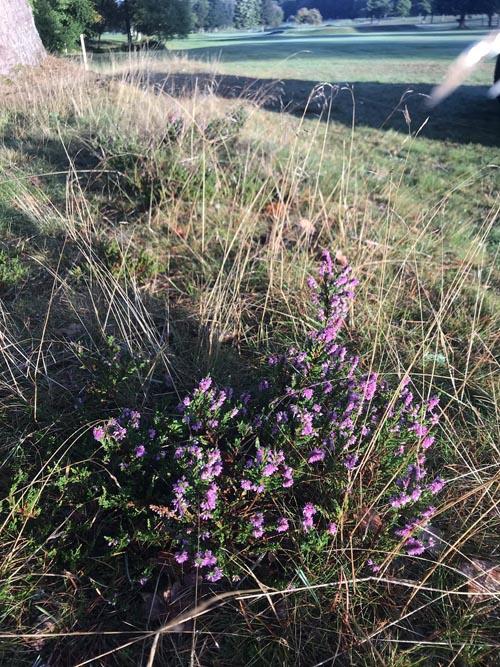
As always, keep the snaps coming and please feel free to contact me via Twitter or by email: [email protected]
Common Reed Beds - November 2018
Regulations regarding waste water here in the UK are there for a reason, namely human and habitat protection. Heavy fines and possible imprisonment (for the worst offenders) can be handed out by the Environment Agency. With this in mind, it is in a golf club’s best interests to develop a system to cleanse its waste water prior to entry into a water course or soakaway.
Numerous machines are available (which can be found in our Greenkeeper International magazine). However, if these are not suitable then BIGGA can assist by designing a reed bed for your site - BIGGA’s Sustainability Executive spent a good deal of his time researching natural methods of water remediation at BSc level and has already developed a good number of beds for our members.
Reed beds cleanse water holistically without the use of electricity, petrol and other fossil fuels by taking washdown water and using holistic phytoremediation (by means of herbs and aquatic plants to clean water) to return water back to the ground as bacteria free as possible.
Reed beds can be built in-house by the greenkeeping team and require minor yearly inputs to maintain. Costs to build, compared to other methods, are minimal and once running are an ideal habitat for small birds and invertebrates to use.
Contact James Hutchinson at: [email protected] or 07767242863 for further information.
Golf Course Ecology Visits - October 2018
Welcome to the latest blog by BIGGA’s Membership Services Manager for Ecology and Sustainability.
The last three blogs have covered ways to become more sustainable and wildlife friendly. This month, however, we will be mostly concentrating on some of our recent course visits and the methods you guys are using to maintain your ecology. Hope you enjoy!
The month started off with a mammoth journey to some of the most Southern regions of England, namely Poole in Dorset (awfully warm), then off to The West and then latterly finishing up in minus degrees Scotland…. but I cared not a jot as Caledonia is as beautiful a place as you are likely to find.
Ripon City GC; Northampton GC; Saddleworth; Belfry, Broadstone, Sherbourne, Cricket St Thomas; Gloucester; Willesley Park; Wakefield; Muckhart; Shrigley Hall; RAC Club; Chipstead; Hoebridge (Environment Agency meeting) were this month’s recipients of a visit from yours truly with Wakefield taking up the offer of a full course environmental report, whereas Muckhart are seeking assistance with a reed bed washdown system.
It turns out that one or two of these smashing golf courses have a hidden-in-plain-sight rarity in the shape of an ancient tree. You may have gathered from past blogs and Twitter updates that I’m a bit of a tree hugger and that I send information to the Ancient Tree Forum (a government backed group who aim to record all our large and gnarly trees) on a regular basis. Well wait until you get a load of Northampton and Willesley Park’s biggies! These are about 600 and 1000 years old respectively – what stories do they have locked away?


Let me know if you have an oldie on your course and I’ll record it for you.

The team at Chipstead, Surrey have four bee hives onsite and are in the process of developing larger wildflower meadows for the bees to forage in.
Two sites have been identified to be turned over from unwanted scrubland (rank grasses and old tipping grounds) this forthcoming winter (2018/ 19) and we look forward to seeing the results guys!
Cricket St Thomas in Somerset have been cracking on with a fine amount of woodland management of late which will only be of benefit to the course and its wildlife.
By removing selected trees, the chaps have allowed more air and sunlight through to the underlying grasses. The timber removed has been stacked nearby as ecopiles for saprophytes (decaying wood eaters and dwellers).
Smashing stuff!

I never tire of the views you guys have from your offices and here’s an example why. Muckhart in Perth and Kinross are as good as you can get and the greenkeepers there are fully aware of this. One thing I often say is that it appears many trees were planted in the 1970s and are now reaching heights where they are blocking out views. That’s up to you whether you want trees or views but I always say that views are your USP (unique selling point), so do not lose them through incorrect tree choices and locations…think ahead 20 or 30 years and visualise what your course will look like after tree plantings – as mentioned, I’m a tree hugger, but only if they’re in the right place.
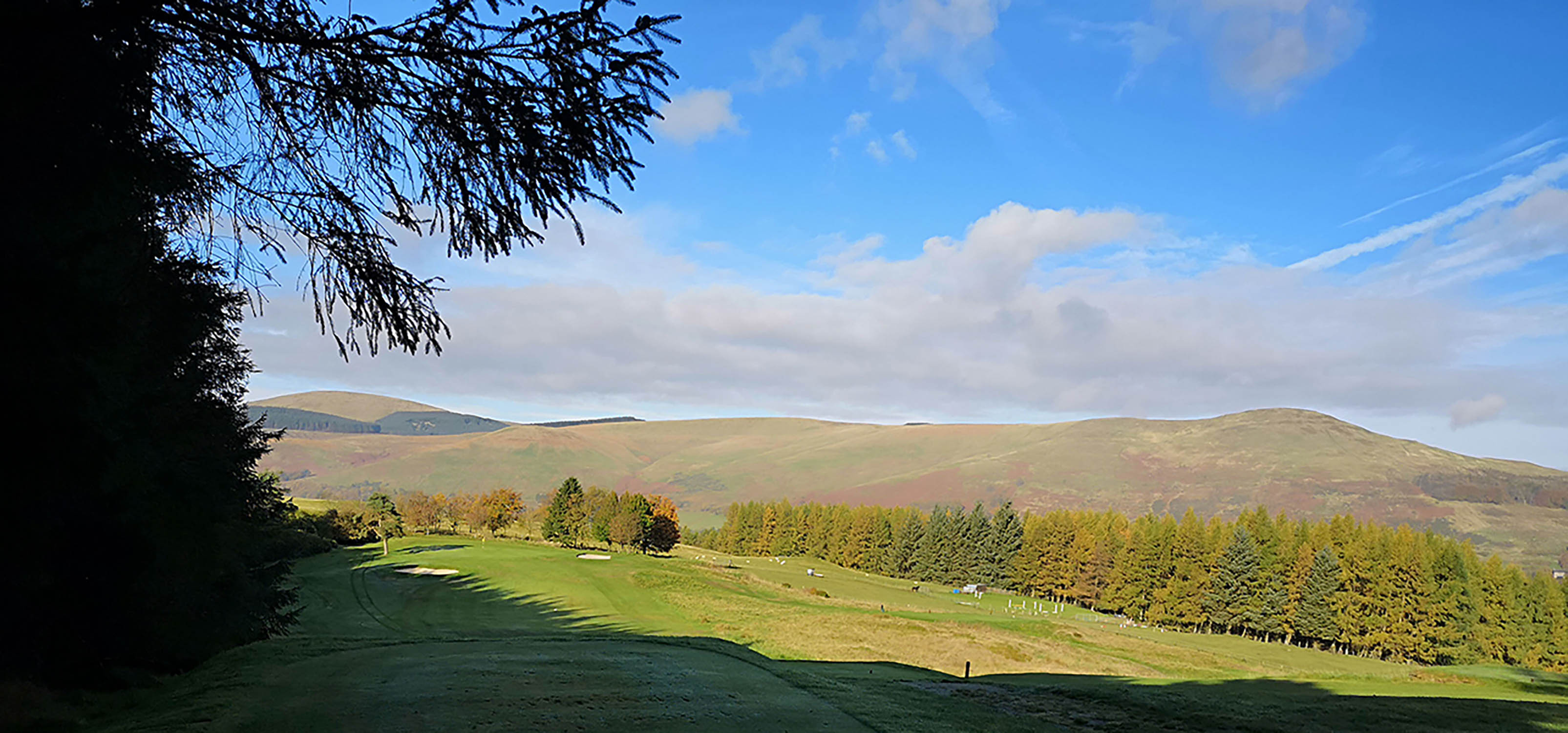
James Hutchinson.
- Membership
- Our People
- BIGGA Regions
- Our Business Affiliates
-
Greenkeeping
-
History of Greenkeepers' Associations
- About the author
- Introduction (Pre-1912)
- 1912 - 1919
- 1920 - 1929
- 1930 - 1939
- 1940 - 1949
- 1950 - 1959
- 1960 - 1969
- 1970 - 1979
- 1980 - 1987
- EIGGA 1983 - 1986
- Greenkeeper Education and Training
- Greenkeeping Families
- Greenkeepers' Associations and Golf
- BIGGA National Tournament
- Publications for Greenkeepers' Associations
- Association Officials
- Greenkeeping Acronyms
- Sustainable Golf
- Ecology Bulletin
- GreenCast Weather Forecast
-
History of Greenkeepers' Associations
- Affiliated Associations
- Women in Golf Charter
- ThankAGreenkeeper Day
- BIGGA's Sustainability Pledge

Visit Operation Pollinator to see what it can do for your golf course
Book a visit from James Hutchinson





